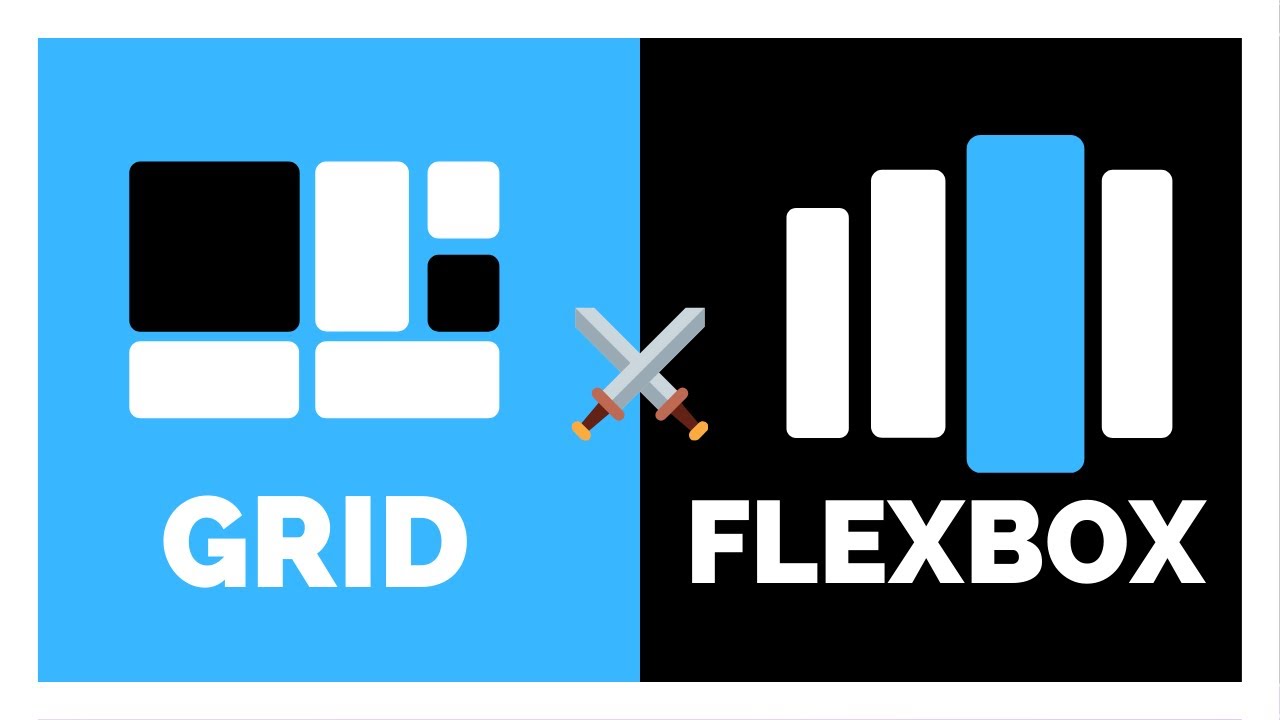Grid vs. Flexbox in Modern Web Design: A Detailed Comparison with Use Cases
 Ahmed Raza
Ahmed Raza
In web design, CSS Grid and Flexbox are two powerful layout tools that have transformed how developers approach layouts and responsiveness. While both serve to structure web elements, they are designed with distinct purposes and excel in different scenarios. Understanding their strengths, limitations, and best-use cases is essential to selecting the right tool for the right project.
Introduction to CSS Grid and Flexbox
CSS Grid: CSS Grid is a two-dimensional layout system designed for creating complex, multi-dimensional layouts. It allows you to work with both rows and columns, making it suitable for building more intricate, grid-like designs with a consistent structure.
Flexbox: Flexbox, short for "Flexible Box Layout," is a one-dimensional layout system that is ideal for distributing space along a single row or column. Flexbox was created to handle complex alignment and distribution of space within a container, making it well-suited for simpler and more flexible layouts that require alignment along a single axis.
Comparison Overview: Grid vs. Flexbox
| Feature | CSS Grid | Flexbox |
| Layout Dimension | Two-dimensional (rows and columns) | One-dimensional (row or column) |
| Best Use Cases | Complex layouts, multi-row, and column layouts | Simple, linear layouts, alignment, and distribution |
| Browser Compatibility | Well-supported across major browsers | Well-supported across major browsers |
| Flexibility | High for static grid-based layouts | High for dynamic, flexible layouts |
| Ease of Learning | More complex, requires grid-specific properties | Easier to learn, uses straightforward properties |
| Performance | May be slightly more demanding in complex grids | Efficient for simpler layouts |
Use Cases and Examples of CSS Grid and Flexbox
When to Use CSS Grid
CSS Grid is ideal for layouts that require both rows and columns to align and size elements precisely, such as gallery displays, dashboards, or complex page layouts. For example, news websites and social media feeds commonly use grid layouts to organize content into a structured, grid-like format.
Complex Layouts: CSS Grid is well-suited for grid-based designs that demand precise control over both axes, such as image galleries, product listings, or dashboard layouts.
Page Structure Layouts: CSS Grid excels in creating the overall structure of a page, such as dividing content into headers, footers, sidebars, and main content areas.
Example: BBC News Website
The BBC News website employs CSS Grid for its main content layout, displaying news articles in a structured, modular grid. By using CSS Grid, the BBC ensures that each content section aligns in a clean, uniform layout, providing an intuitive browsing experience. CSS Grid enables them to control spacing, column width, and row height for each news item, allowing the content to adapt fluidly across different screen sizes.
When to Use Flexbox
Flexbox is a better choice for layouts that focus on distributing and aligning items along a single axis, such as navigation bars, buttons, and form layouts. Flexbox’s alignment properties make it suitable for simpler, more responsive layouts that don’t require complex grids.
Alignment and Distribution: Flexbox is designed for scenarios where content alignment (center, space-around, space-between) is essential.
Single-Row Layouts: Flexbox is highly effective for layouts where items should align in a single row, such as horizontal navigation bars or row-based galleries.
Example: Spotify Website
Spotify's website design demonstrates Flexbox's flexibility by aligning navigation links and various sections within the webpage. Flexbox is used for arranging buttons, dropdowns, and form controls along a single axis, allowing quick adaptation to different screen sizes. Flexbox's flexibility simplifies alignment and spacing without extensive layout reconfiguration.
Pros and Cons of CSS Grid
Pros of CSS Grid
Two-Dimensional Layout: CSS Grid enables control over both columns and rows, making it ideal for complex layouts.
Explicit Positioning: Developers can place items in specific grid cells, providing precise control over layout.
Alignment Control: CSS Grid allows individual elements to align within their specific cell, offering advanced control over layout.
Cons of CSS Grid
Steeper Learning Curve: CSS Grid syntax can be more challenging for beginners.
Limited Flexibility for Single Axis Layouts: CSS Grid can be overkill for simple, single-row or column-based layouts, where Flexbox is simpler and more efficient.
Slight Performance Overhead: CSS Grid, when used excessively, may lead to a slight performance dip in complex layouts due to increased layout calculations.
Pros and Cons of Flexbox
Pros of Flexbox
Responsive and Dynamic: Flexbox is excellent for creating layouts that can dynamically change and adapt based on available space.
Easier to Learn: With a straightforward syntax, Flexbox is often easier to grasp, especially for simpler layouts.
Flexible Content Alignment: Flexbox provides flexible alignment options along a single axis, making it ideal for aligning navigation bars, buttons, and form fields.
Cons of Flexbox
One-Dimensional Limitation: Flexbox is designed to work with a single axis, which can limit its effectiveness for complex, multi-dimensional layouts.
Less Control Over Rows and Columns Simultaneously: Flexbox lacks the explicit grid structure, making it harder to achieve a highly structured layout.
Complex Alignments Can Be Tricky: For layouts with many nested elements, Flexbox’s alignment properties can sometimes lead to unexpected behavior, requiring careful adjustments.
Combining CSS Grid and Flexbox
In many real-world applications, combining both CSS Grid and Flexbox within a project is an optimal solution. A common approach is to use CSS Grid for the overall page layout and Flexbox for component-level alignment within grid items.
Example: Pinterest Website
Pinterest uses a combination of CSS Grid and Flexbox to structure its layout. CSS Grid is employed to create the overall grid-based layout that organizes image cards, while Flexbox is used within each card to align content, like titles and descriptions. This approach offers Pinterest a scalable, organized structure while allowing flexibility and responsiveness at the individual element level.
Development Example: Building a Basic Layout with Grid and Flexbox
Here’s an example layout structure using both CSS Grid and Flexbox:
HTML Structure
<div class="container">
<header class="header">Header</header>
<nav class="nav">Navigation</nav>
<main class="main-content">
<div class="content-item">Content 1</div>
<div class="content-item">Content 2</div>
<div class="content-item">Content 3</div>
</main>
<footer class="footer">Footer</footer>
</div>
CSS Layout using CSS Grid and Flexbox
/* CSS Grid for Main Layout */
.container {
display: grid;
grid-template-areas:
"header header header"
"nav main main"
"footer footer footer";
grid-template-columns: 1fr 2fr;
gap: 10px;
}
.header { grid-area: header; }
.nav { grid-area: nav; }
.main-content { grid-area: main; display: flex; flex-wrap: wrap; }
.footer { grid-area: footer; }
/* Flexbox for Content Items */
.content-item {
flex: 1 1 30%; /* Flexbox for responsive, flexible width */
margin: 5px;
padding: 20px;
background-color: #ddd;
}
In this example:
CSS Grid structures the overall layout into three main areas (header, main content, and footer).
Flexbox is applied within the
.main-contentarea to align and wrap the content items in a flexible, responsive way.
Conclusion
Choosing between CSS Grid and Flexbox is often based on the layout’s specific needs:
Use CSS Grid when dealing with complex layouts that require control over both rows and columns. This is ideal for grid-based layouts with multi-dimensional organization.
Use Flexbox for simpler, one-dimensional layouts that need flexible alignment along a single axis, such as navigation bars and content alignment within containers.
Both CSS Grid and Flexbox are well-supported across major browsers and have distinct advantages depending on the design complexity. Combining both tools allows developers to create optimized layouts that are flexible, responsive, and aligned with modern design needs, as seen in examples from sites like BBC News and Pinterest.
Subscribe to my newsletter
Read articles from Ahmed Raza directly inside your inbox. Subscribe to the newsletter, and don't miss out.
Written by

Ahmed Raza
Ahmed Raza
Ahmed Raza is a versatile full-stack developer with extensive experience in building APIs through both REST and GraphQL. Skilled in Golang, he uses gqlgen to create optimized GraphQL APIs, alongside Redis for effective caching and data management. Ahmed is proficient in a wide range of technologies, including YAML, SQL, and MongoDB for data handling, as well as JavaScript, HTML, and CSS for front-end development. His technical toolkit also includes Node.js, React, Java, C, and C++, enabling him to develop comprehensive, scalable applications. Ahmed's well-rounded expertise allows him to craft high-performance solutions that address diverse and complex application needs.